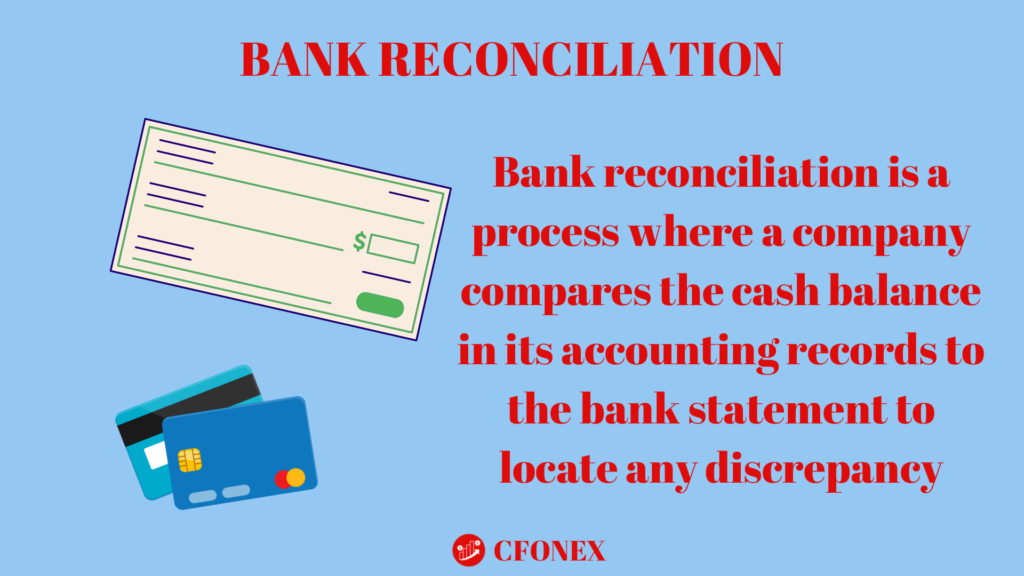Bank reconciliation is a process where a company compares its cash balance to its bank statement to locate any discrepancy.

What is Bank Reconciliation?
Bank reconciliation is the process of comparing and matching a company’s financial records with the bank’s records to ensure that they are consistent and accurate. This process helps identify and correct discrepancies between the two sets of records, ensuring that the company’s cash balance is accurate and up-to-date.
Why Bank Reconciliation is Important
- Accuracy: Ensures that the company’s financial statements accurately reflect its cash position.
- Error Detection: Helps identify errors or discrepancies in both the company’s and the bank’s records, such as bank errors or recording mistakes.
- Fraud Prevention: Helps detect unauthorized transactions or fraudulent activity.
- Financial Management: Provides insight into cash flow and helps with better financial planning and control.
Steps in the Bank Reconciliation Process
- Obtain Bank Statement:
- Get the most recent bank statement from the bank, which lists all transactions, including deposits, withdrawals, and fees.
- Prepare Company’s Records:
- Review the company’s cash account ledger from the general ledger or accounting software. Ensure all transactions are recorded up to the same date as the bank statement.
- Compare Transactions:
- Match each transaction listed on the bank statement with those in the company’s records. Check for:
- Deposits: Ensure all deposits recorded in the company’s ledger appear on the bank statement.
- Withdrawals: Verify that all withdrawals or payments recorded in the ledger are listed on the bank statement.
- Match each transaction listed on the bank statement with those in the company’s records. Check for:
- Identify Discrepancies:
- Look for differences such as:
- Outstanding Checks: Checks written by the company that have not yet cleared the bank.
- Deposits in Transit: Deposits made by the company that have not yet been processed by the bank.
- Bank Errors: Mistakes made by the bank that need correction.
- Company Errors: Mistakes made in the company’s records, such as misrecorded amounts.
- Look for differences such as:
- Adjust the Bank Statement and Company Records:
- Bank Statement Adjustments: Add any interest earned or bank fees not previously recorded.
- Company Records Adjustments: Adjust the company’s cash ledger for errors found, such as recording mistakes or missing transactions.
- Reconcile the Balances:
- Bank Balance: Start with the ending balance on the bank statement and adjust for outstanding checks and deposits in transit.
- Company Cash Balance: Start with the ending balance in the company’s cash ledger and adjust for any errors found and corrections made.
- Verify and Document:
- Ensure that the adjusted bank balance matches the adjusted cash balance in the company’s records.
- Document the reconciliation process, noting any discrepancies and adjustments made. Keep a record for future reference and auditing purposes.
Example of a Simple Bank Reconciliation
- Bank Statement Ending Balance: $10,000
- Company Ledger Ending Balance: $9,800Adjustments:
- Outstanding Checks: $300
- Deposits in Transit: $500
- Bank Fees: $50 (recorded in the bank statement but not in the company ledger)
- Company Error: $100 (recorded as a deposit but was actually a payment)
- $10,000 – $300 (outstanding checks) + $500 (deposits in transit) = $10,200
- $9,800 + $100 (error correction) – $50 (bank fee) = $9,850
- Adjusted Bank Statement Balance: $10,200
- Adjusted Company Ledger Balance: $9,850 (need to find the remaining $350 discrepancy)
- After additional investigation, the $350 discrepancy is identified and resolved.
Frequency and Best Practices
- Frequency: Reconciliation should be done regularly, typically monthly, to ensure that errors or issues are identified and resolved in a timely manner.
- Best Practices:
- Use reconciliation software or tools to streamline the process.
- Separate duties: Ensure that the person performing the reconciliation is not the same person handling cash transactions.
- Document and review the reconciliation process regularly for accuracy and compliance.
Bank reconciliation is a crucial process for maintaining accurate financial records and ensuring the integrity of financial reporting.
Leave a Reply